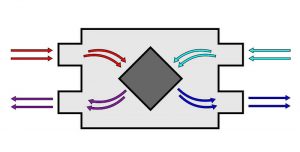We produce heat all the time and all day long. Whether you turn on the boiler, switch on the oven or do the washing, a large amount of heat is generated and wasted in the process. When a factory manufactures the products we use daily, heat is generated and wasted. The generated heat disappears into the atmosphere through vents in our homes or inefficient industrial flues. If there is a way to preserve the heat generated daily, it can be used for different purposes. That’s where heat recovery systems come in handy.
Contents
- 1 Key Takeaways
- 2 What Is A Heat Recovery System?
- 3 How Do Heat Recovery Systems Work?
- 4 How Efficient Are Heat Recovery Systems?
- 5 Types Of Heat Recovery Systems
- 6 What Are The Uses Of Heat Recovery Systems?
- 7 How Much Do Heat Recovery Systems Cost?
- 8 What Are The Benefits Of A Heat Recovery System?
- 9 Heat Pump Source: Reliable Heating and Cooling Solutions
- 10 Conclusion
Key Takeaways
- Heat recovery systems capture and reuse wasted heat generated in various processes, making them an energy-efficient solution for homes and businesses.
- Heat recovery systems extract heat from stale air in wet rooms and provide clean, warm air, reducing energy consumption and improving indoor air quality.
- Various types of heat recovery systems are available, including thermal wheel, plate heat, run-around coil, and heat pipe technologies, each with efficiency and maintenance considerations.
What Is A Heat Recovery System?
A heat recovery system will ensure that the heat we generate daily isn’t wasted. It can be the heat generated in a restaurant kitchen or the warmth created in the office environment. Heat recovery systems work to draw heat from places that you may never imagine such as the ground in your garden or the air outside. A good heat recovery system will reduce the amount of money you pay for your energy bills.
How Do Heat Recovery Systems Work?
A heat recovery system work by extracting stale air and moist from wet rooms in your home. The system will recover the lost heat from the extracted air. The system will then supply clean and fresh air that is heated using the recovered warmth of the extracted heat. A heat recovery system works through a heat recovery ventilation unit. This unit is usually located in the attic, roof area or the plant room of the building.
 Heat exchange is the process of heat travelling towards the region of lower temperature when something hot passes next to something cold. With a heat recovery system in your home, you will make use of what already exists in your home and reduce the collective impact on the environment. We lose a considerable amount of heat to the environment daily. The recovery system works by using warm air or water in the building in a positive way. The recovery system works independently of the normal heating system in your home. Each room in your home will have ventilation valves with filters to supply air in and out of the room – which will lead to the heat recovery unit. The system moves stale air through the pipes whilst drawing in cold air from the outdoors through the ducts.
Heat exchange is the process of heat travelling towards the region of lower temperature when something hot passes next to something cold. With a heat recovery system in your home, you will make use of what already exists in your home and reduce the collective impact on the environment. We lose a considerable amount of heat to the environment daily. The recovery system works by using warm air or water in the building in a positive way. The recovery system works independently of the normal heating system in your home. Each room in your home will have ventilation valves with filters to supply air in and out of the room – which will lead to the heat recovery unit. The system moves stale air through the pipes whilst drawing in cold air from the outdoors through the ducts.
How Efficient Are Heat Recovery Systems?
Heat recovery systems allow us to make the most of the energy we produce. The efficiency of the system can differ depending on the type of heat recovery system you have. Many other factors affect the efficiency of a heat recovery systems such as the age and make of a particular boiler and how airtight your home is. The size and age of the property are also important considerations where the efficiency of the recovery system is concerned. An older property will have widespread heat loss issues due to the age and nature of the building. Newer buildings will have better insulation and less loss of heat. These are some of the factors that can affect the efficiency of your heat recovery system.
Types Of Heat Recovery Systems
Heat recovery systems come in a wide variety of forms. But all of these systems involve some form of a heat exchanger. The system will sit in the building – in the loft or on the roof – and pipes are fed down from the system into each room of the house. These pipes will draw out the stale air and replace it with warm and clean air. Here are some of the popular heat recovery systems out there.
Thermal Wheel Heat Recovery
This is the most efficient heat recovery system on the market. They are much bigger and made up of two large wheels with a honeycomb array. One half will draw in the stale air inside while the other half will provide fresh air. The wheels of the system will rotate in the opposite direction to each other. The wheels are made of a wide variety of materials including aluminium.
Plate Heat Or Recuperator Technology
This system is more common than thermal wheel systems because it can be used on a smaller scale. It consists of a box with a series of parallel plates made of plastic or metal. They allow the extracted air to pass over the incoming air. The plate heat recovery system comes with an efficiency of 70% at its best.
Run Around Coil (Closed-Loop) Technology
This system has two coils connected by a circuit of pipes. Water is used to charge the circuit. It picks up the heat from the exhaust pipe and transfers it to the supply air coil. These systems are used when 2 air streams aren’t close enough for more effective systems like thermal wheel or plate heat systems.
Heat Pipe Technology
These systems have the lowest maintenance out of all the heat recovery systems on the market. They are used only where the air handling is done in one system. The system uses a tube with a refrigerant to extract the heat from the exhaust air and pass it to the supply air. The system uses vertical and horizontal pipes for the process. Vertical arrays are more efficient than the horizontal arrays.
What Are The Uses Of Heat Recovery Systems?
Heat recovery systems are used in both commercial and domestic environments. There is a wide range of uses for this kind of technology. It heats ventilation spaces, preheats air and water to increase the efficiency of the boiler and reduce the energy costs, and water heating purposes. The technology is also used for many industrial processes including large-scale drying.
How Much Do Heat Recovery Systems Cost?
You should expect to pay between £2,000 and £5,000 for a domestic heat recovery system. The cost of the system can vary depending on the size of your property and the technology you plan to use. The amount of retrofitting needed may also increase the price of the system. Industrial and commercial heat recovery systems can cost thousands of pounds. But the energy-saving you get from an efficient commercial or industrial heat recovery system will offset the initial investment very quickly. You should research before opting for the best heat recovery system for your home or office. There are different types of systems on the market. You can pick the best system to suit your needs and budget with the right amount of research.
What Are The Benefits Of A Heat Recovery System?
There are many benefits of a heat recovery system. Here are some of the most important benefits of a good heat recovery system.
Clean And Fresh Air
The system will continuously supply clean and fresh air into your home or office. You will have access to clean and fresh air during the day and night with a good heat recovery system. Fresh air will remove indoor pollutants and keep the inhabitants healthy at all times. It will also help to lower indoor odour and the humidity levels. It will create a healthy home for you and your family.
Energy Efficient
 Heat recovery systems will reduce your energy bills and save money in the long run. These systems are designed to continuously operate at a lower rate compared t most of the other systems. They will reduce your electricity consumption and guarantee lower heating bills over time. That is why you need to invest in the best heat recovery system for your home or office. There are many systems to choose from. Make sure you do the research and select the right system for your home or office.
Heat recovery systems will reduce your energy bills and save money in the long run. These systems are designed to continuously operate at a lower rate compared t most of the other systems. They will reduce your electricity consumption and guarantee lower heating bills over time. That is why you need to invest in the best heat recovery system for your home or office. There are many systems to choose from. Make sure you do the research and select the right system for your home or office.
Compact In Size
Heat recovery systems can be installed in your attic or basement or adjoining garage because they are compact in size. Some models can be fitted in a hot-press within your kitchen. The main control unit will be located in the utility room or the kitchen. The system can be fitted in any area on your home because they are compact in size. That is why you need to invest in a heat recovery system for your home or office.
Eliminating Condensation
Condensation is a common issue faced by many homeowners of this day and age. The heat recovery system can remove the water vapour produced in your home. There won’t be any moisture condensation in your home to cause dampness and encourage the growth of mould and mildew in the long run. You should always invest in the right heat recovery system for your home or office. Your personal preference and budget play an important part when choosing the best system for your space.
Heat Pump Source: Reliable Heating and Cooling Solutions
At Heat Pump Source, we take pride in our unwavering commitment to serving the UK with top-tier HVAC solutions. From the efficiency of heat pumps and the cool relief of air conditioning to the warmth of boilers, radiators, and underfloor heating, our dedicated team is always at the forefront of innovation. We understand the unique needs of every household and business, and we strive to provide dependable health and cooling products and services that are tailored just for you. Ensuring your comfort and satisfaction is our utmost priority. Whether you have questions, need guidance, or require support, we’re always here to assist. Please don’t hesitate to contact us; we’re eager to be of service.
Conclusion
If you are looking for the best heat recovery systems on the market, you have come to the right place. Heat recovery systems come with numerous benefits to homeowners. There are many things to consider when investing in the best heat recovery system for your home.
About the Author
At Heat Pump Source, our articles are the product of a collaborative effort among a team of highly skilled HVAC experts. Our dedicated professionals, hailing from diverse backgrounds in heating, ventilation, air conditioning, and refrigeration, contribute their extensive knowledge and experience to every piece of content. This multidisciplinary approach ensures comprehensive coverage. Our commitment is to deliver authoritative, reliable, and tailored advice to meet the unique needs of every household and business across the UK.

